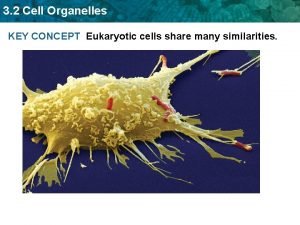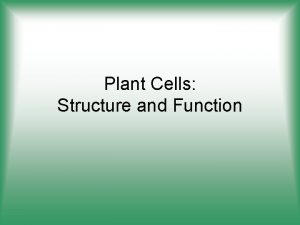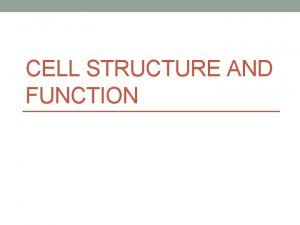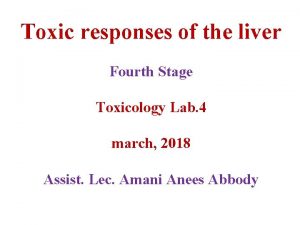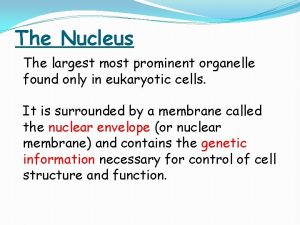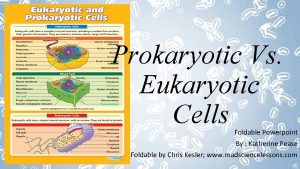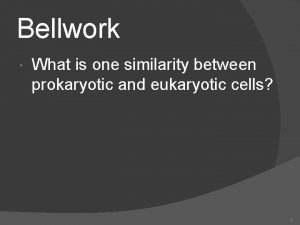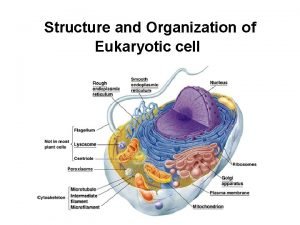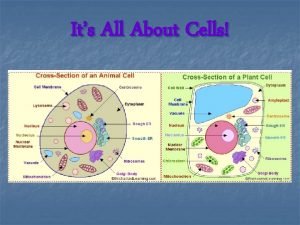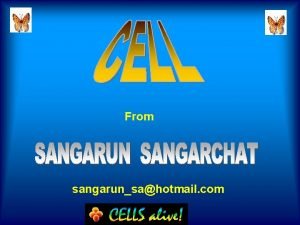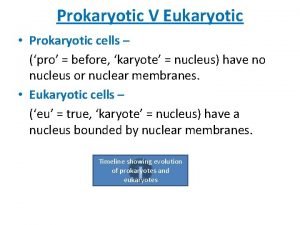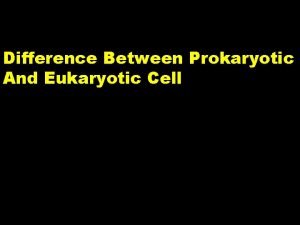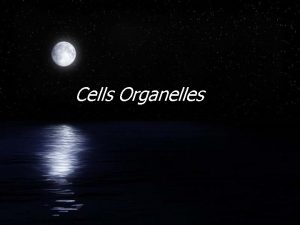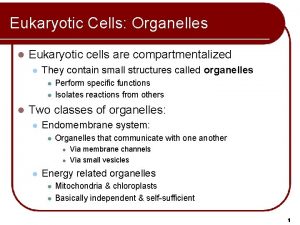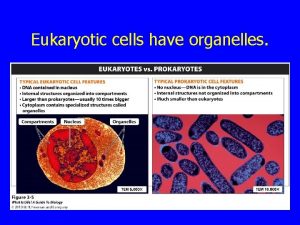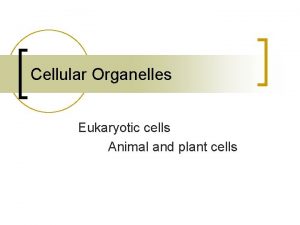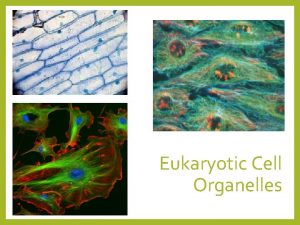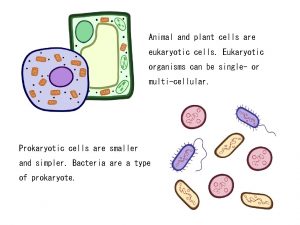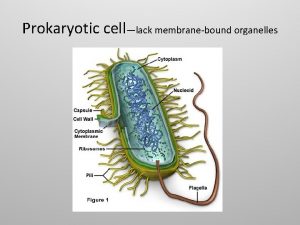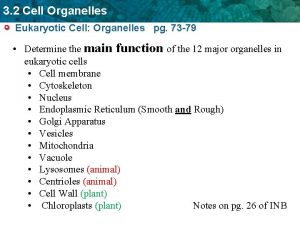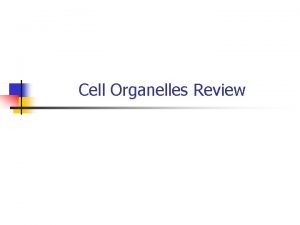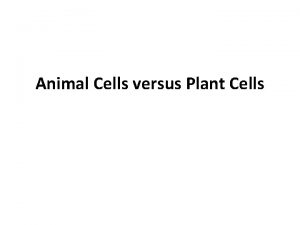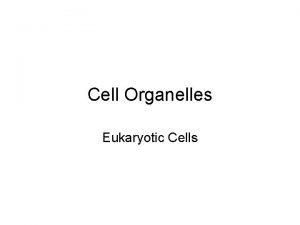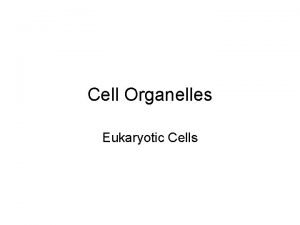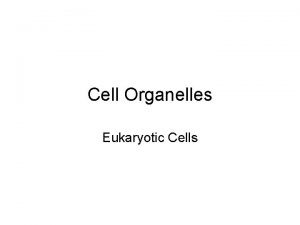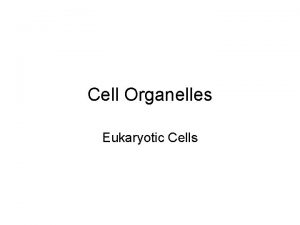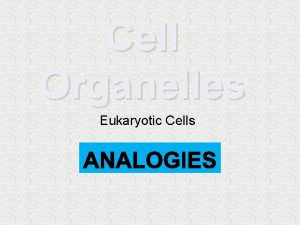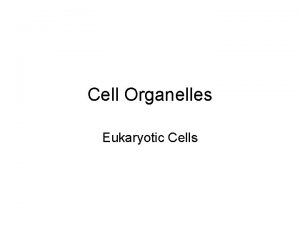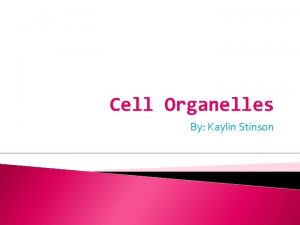Eukaryotic Cells Organelles Eukaryotic Cells FDivided Into Plant























- Slides: 23

Eukaryotic Cells & Organelles

Eukaryotic Cells FDivided Into Plant Cells & Animal Cells FBoth of these have Organelles: structures that enable the cell to live, grow, and reproduce.

A Plant Cell Organelles • Cell Wall • Cell Membrane • Cytoplasm • Nucleus • Endoplasmic Reticulum • Ribosomes • Large Vacuole • Mitochondria • Chloroplasts & Other Plastids • Golgi Apparatus (Complex)

An Animal Cell Organelles: • Cell Membrane • Cytoplasm • Nucleus • Endoplasmic Reticulum • Ribosomes • Small Vacuoles • Mitochondria • Golgi Apparatus (Complex) • Lysosomes

Organelles F What’s holding it all together? F Cell Wall FFound in plant and algae cells FMade of cellulose FProvides strength and support FHelps plants protect themselves from too much water entering or leaving the cell FHas a defined shape (Boxlike) FCells & Heredity P. 13, par. 2

Organelles What’s Holding It All Together? Cell Membrane Cells & Heredity p. 13 par. 3 ALL cells are covered by a cell membrane. Ø Its job is to : Ø keep the cytoplasm in Ø allow waste out and nutrients in Ø interact with other cells. Ø Made of phospholipid bilayer. Ø Hydrophobic: hate water (tails) Ø Hydrophilic: loves water (heads)

How particles move FThe cell may take large particle FInto the cell (Endocytosis) FPhagocytosis: Cell eating FPinocytosis: Cell drinking FOut of the cell through (Exocytosis)

Organelles FCell’s Information Station: Nucleus FLargest and most visible organelle in eu. K cell FMeans “kernel” or “nut” FStores DNA that has information for making proteins. FCells & Heredity p. 14, par. 1

Nucleolus v. Makes Ribosomes v. Small, round structure located inside the Nucleus Cells & Heredity, p. 14, par. 3 Nuclear Membrane (Envelope) v. Controls what is allowed to enter or leave the nucleus v. Thin membrane that surrounds & takes the shape of the nucleus. Cells & Heredity, p. 14, par. 1

Nucleus, Nucleolus, Nuclear Membrane

Protein Factory FRibosomes: Cells & Heredity, p. 14, par. 3 FSmallest, but most abundant organelle in the cell FPresent in all cells FDo not have a membrane covering FServe as the protein building location

Cytolpasm v. Present in all cells v. Thick, clear, jelly-like fluid v. Carries, holds, cushions, & helps protect other organelles inside a cell Cells & Heredity, p. 15, par. 1

Smooth Endoplasmic Reticulum F Does not have ribosomes, appears as a smooth maze F Makes lipids for use in/out side the cell. F Break down drugs and other chemicals that could damage the cell F Internet resources F Biologyabout. com

Rough Endoplasmic F Has ribosomes, appears Reticulum “bumpy” F Helps make membranes & other antibodies such as insulin F Located close to the nucleus F Internet resources (Biologyabout. com)

Cell’s Power Plant FMitochondria: FBreaks down food molecules into ATP for energy FRod-Shaped, & Surrounded by two membranes: the inner membrane has folds where most of ATP is made FNeed oxygen to work FActive cells like those in the liver and heart have thousands of them FCells & Heredity, p. 15, par. 2

Cell’s Power Plant FChloroplasts: FFound in plant and algae cells FMake food (sugar) from sunlight FHave flattened membrane covered sacs that look like coins that contain chlorophyll which makes chloroplast green FChlorophyll traps sunlight to make sugar through photosynthesis FCells & Heredity, p. 19, par. 1

Other Common Plastids FChloroplasts: the most commonly known of the Plastids—Green in color FChromoplasts: Allow storage of pigments that give plants colors other than green—red, orange, etc. FLeucoplasts: Store starches & lipids, give plants a white color

Endosymbiotic theory FWhere did they come from? FScientist believe that mitochondria and chloroplast began as pro. K and were eaten by larger cells. FEvidence that supports this theory: FThey are about the same size as bacteria FThey are surrounded by two membranes

Cell’s Packaging Center FGolgi Complex: FLooks like flattened sacs & tubes, similar to the ER but closer to the cell membrane FTakes in proteins & other materials from the ER, packages them in vesicles, then sends them to other parts of the cell or to other cells FFinal products are enclosed in Golgi membrane and then pinched off for transport in vesicles. FCells & Heredity, p. 18, par. 1

Golgi Complex

Cell’s Storage Centers FEu. K have membrane covered sacs called vesicles. FForm either when… FPart of membrane pinches of ER or Golgi Complex FCell membrane engulf something from outside the cell.

Cell’s Storage Centers FMost plant cells have a large membrane covered chamber called a vacuole. FIt is used to store water, food, or other material needed by the cell. Also holds waste until it can be removed by the cell. FAnimal cells also have smaller vacuoles that serve the same purpose cells & Heredity, p. 18, par. 2

FLysosome Waste Management FBump into vesicles and secrete enzyme to digest them. FDestroy damaged organelles and get rid of waste FProtects cell from foreign particles that enter the cell by destroying them FSometimes lysosome membranes break and the enzymes kill the cell. FTadpole-frog FHuman webbed fingers. FCells & Heredity, p. 19, par. 2
 Organelles in eukaryotic cells worksheet
Organelles in eukaryotic cells worksheet Venn diagram of plant and animal cells
Venn diagram of plant and animal cells Cells cells they're made of organelles meme
Cells cells they're made of organelles meme What cell type
What cell type Eukaryotic plant cell
Eukaryotic plant cell Eukaryotic vs prokaryotic cell
Eukaryotic vs prokaryotic cell Prokaryotic cell
Prokaryotic cell Staphylococcus aureus prokaryotic or eukaryotic
Staphylococcus aureus prokaryotic or eukaryotic Venn diagram for animal and plant cells
Venn diagram for animal and plant cells Mitochondria double membrane function
Mitochondria double membrane function Liver cells organelles
Liver cells organelles Most prominent organelle in eukaryotic cells
Most prominent organelle in eukaryotic cells Eukaryotic cells
Eukaryotic cells Three parts of cell theory
Three parts of cell theory Diff between prokaryotes and eukaryotes
Diff between prokaryotes and eukaryotes Similarity between prokaryotic and eukaryotic cells
Similarity between prokaryotic and eukaryotic cells Fungi locomotion present or absent
Fungi locomotion present or absent Are eukaryotic cells living or nonliving
Are eukaryotic cells living or nonliving Lable
Lable Prokaryotic and eukaryotic cells chart
Prokaryotic and eukaryotic cells chart Diff between prokaryotic and eukaryotic cells
Diff between prokaryotic and eukaryotic cells How water moves
How water moves Difference between prokaryotic and eukaryotic cells
Difference between prokaryotic and eukaryotic cells Prokaryotic and eukaryotic cells
Prokaryotic and eukaryotic cells
